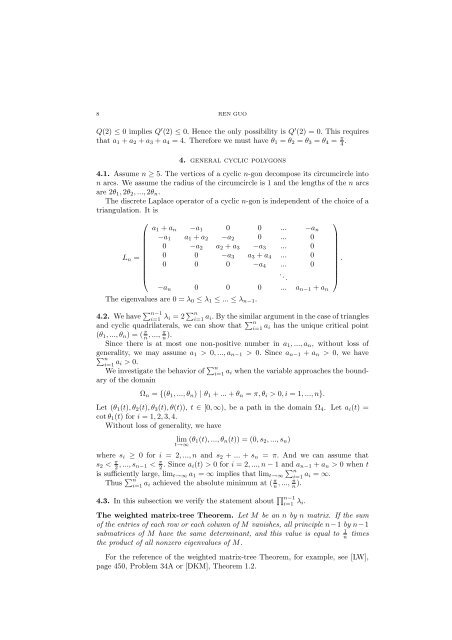Extremum problems for eigenvalues of discrete Laplace operators
Extremum problems for eigenvalues of discrete Laplace operators
Extremum problems for eigenvalues of discrete Laplace operators
You also want an ePaper? Increase the reach of your titles
YUMPU automatically turns print PDFs into web optimized ePapers that Google loves.
8 REN GUO<br />
Q(2) ≤ 0 implies Q ′ (2) ≤ 0. Hence the only possibility is Q ′ (2) = 0. This requires<br />
that a 1 + a 2 + a 3 + a 4 = 4. There<strong>for</strong>e we must have θ 1 = θ 2 = θ 3 = θ 4 = π 4 .<br />
4. general cyclic polygons<br />
4.1. Assume n ≥ 5. The vertices <strong>of</strong> a cyclic n-gon decompose its circumcircle into<br />
n arcs. We assume the radius <strong>of</strong> the circumcircle is 1 and the lengths <strong>of</strong> the n arcs<br />
are 2θ 1 ,2θ 2 ,...,2θ n .<br />
The <strong>discrete</strong> <strong>Laplace</strong> operator <strong>of</strong> a cyclic n-gon is independent <strong>of</strong> the choice <strong>of</strong> a<br />
triangulation. It is<br />
⎛<br />
L n =<br />
⎜<br />
⎝<br />
⎞<br />
a 1 + a n −a 1 0 0 ... −a n<br />
−a 1 a 1 + a 2 −a 2 0 ... 0<br />
0 −a 2 a 2 + a 3 −a 3 ... 0<br />
0 0 −a 3 a 3 + a 4 ... 0<br />
0 0 0 −a 4 ... 0<br />
. ..<br />
⎟<br />
⎠<br />
−a n 0 0 0 ... a n−1 + a n<br />
The <strong>eigenvalues</strong> are 0 = λ 0 ≤ λ 1 ≤ ... ≤ λ n−1 .<br />
4.2. We have ∑ n−1<br />
i=1 λ i = 2 ∑ n<br />
i=1 a i. By the similar argument in the case <strong>of</strong> triangles<br />
and cyclic quadrilaterals, we can show that ∑ n<br />
i=1 a i has the unique critical point<br />
(θ 1 ,...,θ n ) = ( π n ,..., π n ).<br />
Since there is at most one non-positive number in a 1 ,...,a n , without loss <strong>of</strong><br />
∑<br />
generality, we may assume a 1 > 0,...,a n−1 > 0. Since a n−1 + a n > 0, we have<br />
n<br />
i=1 a i > 0.<br />
We investigate the behavior <strong>of</strong> ∑ n<br />
i=1 a i when the variable approaches the boundary<br />
<strong>of</strong> the domain<br />
Ω n = {(θ 1 ,...,θ n ) | θ 1 + ... + θ n = π,θ i > 0,i = 1,...,n}.<br />
Let (θ 1 (t),θ 2 (t),θ 3 (t),θ(t)), t ∈ [0, ∞), be a path in the domain Ω 4 . Let a i (t) =<br />
cot θ 1 (t) <strong>for</strong> i = 1,2,3,4.<br />
Without loss <strong>of</strong> generality, we have<br />
lim (θ 1(t),...,θ n (t)) = (0,s 2 ,...,s n )<br />
t→∞<br />
where s i ≥ 0 <strong>for</strong> i = 2,...,n and s 2 + ... + s n = π. And we can assume that<br />
s 2 < π 2 ,...,s n−1 < π 2 . Since a i(t) > 0 <strong>for</strong> i = 2,...,n − 1 and a n−1 + a n > 0 when t<br />
is sufficiently large, lim t→∞ a 1 = ∞ implies that lim t→∞<br />
∑ n<br />
i=1 a i = ∞.<br />
Thus ∑ n<br />
i=1 a i achieved the absolute minimum at ( π n ,..., π n ).<br />
4.3. In this subsection we verify the statement about ∏ n−1<br />
i=1 λ i.<br />
The weighted matrix-tree Theorem. Let M be an n by n matrix. If the sum<br />
<strong>of</strong> the entries <strong>of</strong> each row or each column <strong>of</strong> M vanishes, all principle n−1 by n−1<br />
submatrices <strong>of</strong> M have the same determinant, and this value is equal to 1 n times<br />
the product <strong>of</strong> all nonzero <strong>eigenvalues</strong> <strong>of</strong> M.<br />
For the reference <strong>of</strong> the weighted matrix-tree Theorem, <strong>for</strong> example, see [LW],<br />
page 450, Problem 34A or [DKM], Theorem 1.2.<br />
.

















